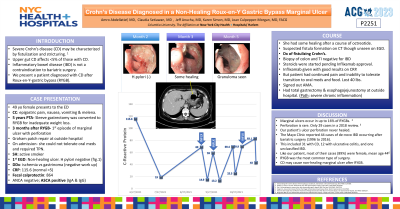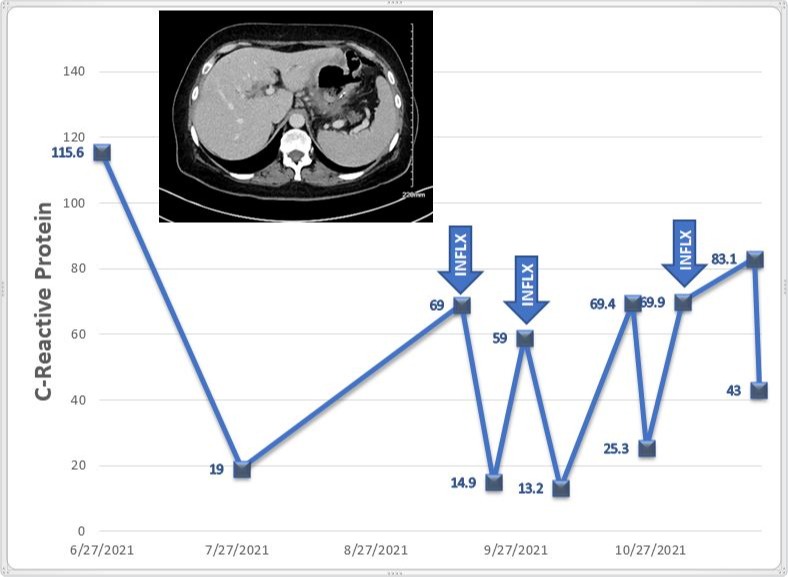Monday Poster Session
Category: IBD
P2251 - Crohn’s Disease Diagnosed in a Non-Healing Roux-en-Y Gastric Bypass Marginal Ulcer
Monday, October 23, 2023
10:30 AM - 4:15 PM PT
Location: Exhibit Hall

Has Audio

Joan Culpepper-Morgan, MD, FACG
Harlem Hospital
Weston, CT
Presenting Author(s)
Amro Abdellatief, MD1, Claudia Setiawan, MD1, Jeff C. Anucha, MD1, Karen Simon, MD2, Joan Culpepper-Morgan, MD, FACG2
1Harlem Hospital Center, New York, NY; 2Harlem Hospital, New York, NY
Introduction: Severe Crohn’s disease (CD) is characterized by fistulization and stricturing. Upper gut CD affects < 5% of those with CD. Inflammatory bowel disease (IBD) is not a contraindication to bariatric surgery. We present a patient diagnosed with CD after Roux-en-Y-gastric bypass (RYGB).
Case Description/Methods: A 49-year-old female presented to the ED for chronic epigastric pain, nausea, vomiting, and melena. She originally had a sleeve gastrectomy 6 years prior that was converted to RYGB one year prior to presentation. Three months following the RYGB she experienced her first marginal ulcer with perforation. She underwent Graham patch repair at an outside hospital. Post op she was unable to tolerate oral medications and required TPN. She was an active smoker. Initial upper endoscopy (EGD) and biopsy ruled out H.pylori. Non-healing due to continued smoking and small vessel ischemia was suspected. Gastrinoma work-up was negative. CD was suspected due to elevated ESR, CRP (115.6), and fecal calprotectin (864). ANCA was negative but ASCA IgA and IgG were positive. Repeat EGD with biopsy revealed granulation tissue with a single non-caseating granuloma. CT abdomen showed evidence of gastric bypass with persistent fat stranding at the gastro-jejunal anastomosis as well as perihepatic inflammation associated with an inflamed remnant stomach (fig.1). No other areas of small bowel or colonic inflammation were identified. Colonoscopy and terminal ileal biopsies were normal. Patient continued to have intractable abdominal pain and inability to tolerate oral intake. She eventually required TPN again. Throughout these admissions the patient had persistently elevated CRP that responded to parenteral steroids yet she could not tolerate oral medications. She was started on infliximab with only partial relief (fig. 1). She continued to lose weight. She eventually presented emergently to an outside hospital and underwent total gastrectomy and esophagojejunostomy. Resected tissue showed severe chronic inflammation.
Discussion: Marginal ulcers occur in up to 16% of RYGBs. Perforation is rare. Only 29 cases in a 2018 review. Our patient’s ulcer perforation never healed. The Mayo Clinic reported 44 cases of de-novo IBD occurring after bariatric surgery (1996 to 2016). This included 31 with CD, 12 with ulcerative colitis, and one unclassified IBD. Like our patient, most of their cases (89%) were female, mean age 44, and RYGB was the most common type of surgery. CD may cause non-healing marginal ulcer in RYGB.

Disclosures:
Amro Abdellatief, MD1, Claudia Setiawan, MD1, Jeff C. Anucha, MD1, Karen Simon, MD2, Joan Culpepper-Morgan, MD, FACG2. P2251 - Crohn’s Disease Diagnosed in a Non-Healing Roux-en-Y Gastric Bypass Marginal Ulcer, ACG 2023 Annual Scientific Meeting Abstracts. Vancouver, BC, Canada: American College of Gastroenterology.
1Harlem Hospital Center, New York, NY; 2Harlem Hospital, New York, NY
Introduction: Severe Crohn’s disease (CD) is characterized by fistulization and stricturing. Upper gut CD affects < 5% of those with CD. Inflammatory bowel disease (IBD) is not a contraindication to bariatric surgery. We present a patient diagnosed with CD after Roux-en-Y-gastric bypass (RYGB).
Case Description/Methods: A 49-year-old female presented to the ED for chronic epigastric pain, nausea, vomiting, and melena. She originally had a sleeve gastrectomy 6 years prior that was converted to RYGB one year prior to presentation. Three months following the RYGB she experienced her first marginal ulcer with perforation. She underwent Graham patch repair at an outside hospital. Post op she was unable to tolerate oral medications and required TPN. She was an active smoker. Initial upper endoscopy (EGD) and biopsy ruled out H.pylori. Non-healing due to continued smoking and small vessel ischemia was suspected. Gastrinoma work-up was negative. CD was suspected due to elevated ESR, CRP (115.6), and fecal calprotectin (864). ANCA was negative but ASCA IgA and IgG were positive. Repeat EGD with biopsy revealed granulation tissue with a single non-caseating granuloma. CT abdomen showed evidence of gastric bypass with persistent fat stranding at the gastro-jejunal anastomosis as well as perihepatic inflammation associated with an inflamed remnant stomach (fig.1). No other areas of small bowel or colonic inflammation were identified. Colonoscopy and terminal ileal biopsies were normal. Patient continued to have intractable abdominal pain and inability to tolerate oral intake. She eventually required TPN again. Throughout these admissions the patient had persistently elevated CRP that responded to parenteral steroids yet she could not tolerate oral medications. She was started on infliximab with only partial relief (fig. 1). She continued to lose weight. She eventually presented emergently to an outside hospital and underwent total gastrectomy and esophagojejunostomy. Resected tissue showed severe chronic inflammation.
Discussion: Marginal ulcers occur in up to 16% of RYGBs. Perforation is rare. Only 29 cases in a 2018 review. Our patient’s ulcer perforation never healed. The Mayo Clinic reported 44 cases of de-novo IBD occurring after bariatric surgery (1996 to 2016). This included 31 with CD, 12 with ulcerative colitis, and one unclassified IBD. Like our patient, most of their cases (89%) were female, mean age 44, and RYGB was the most common type of surgery. CD may cause non-healing marginal ulcer in RYGB.

Figure: Figure 1
Disclosures:
Amro Abdellatief indicated no relevant financial relationships.
Claudia Setiawan indicated no relevant financial relationships.
Jeff Anucha indicated no relevant financial relationships.
Karen Simon indicated no relevant financial relationships.
Joan Culpepper-Morgan indicated no relevant financial relationships.
Amro Abdellatief, MD1, Claudia Setiawan, MD1, Jeff C. Anucha, MD1, Karen Simon, MD2, Joan Culpepper-Morgan, MD, FACG2. P2251 - Crohn’s Disease Diagnosed in a Non-Healing Roux-en-Y Gastric Bypass Marginal Ulcer, ACG 2023 Annual Scientific Meeting Abstracts. Vancouver, BC, Canada: American College of Gastroenterology.
